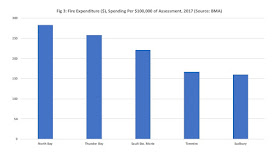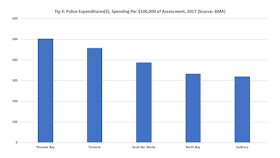



A total of 39,222 ballots were cast for Ward councilors which is lower than the 41,108 cast for mayor. This suggests that there were individuals who voted for mayor and not for their ward councilors. This type of difference was also noted in the At-Large race as the total number of votes cast At-Large was smaller than the potential number given the total vote for Mayor. As for the online/telephone and paper ballot results, there was not substantive difference in the ward outcomes across the two methods with the exception of Neebing where Lynda Rydholm had more paper ballots than Cody Fraser but Cody Fraser won with the online ballots.
The vote share of the winners ranged from a high of 65 percent for Shelby Ch'ng in Northwood to a low of 33 percent for Cody Fraser in Neebing. Current River and McIntyre had the next highest winning vote shares at 59 percent for Andrew Foulds and 50 percent for Albert Aiello. After Neebing Ward, the next lowest shares were 42 percent for Brian Hamilton in McKellar and 44 percent for Brian McKinnon in Red River. Kristen Oliver in Westfort won with 47 percent of the vote. On average, the winning vote share across these seven wards came in at nearly 50 percent - 48.6 percent to be precise.



Given that the total vote share of the winning mayoral candidate was 34 percent while At-Large candidates won with 7 to 11 percent of total votes cast, it suggests to me that most Ward councilors can reasonably claim to have a stronger representative mandate from their respective constituencies than either the At-Large candidates or even the Mayor. Of course, one of the reasons for the more fractured vote distribution in these other races was the large number of candidates. Even in the ward races, there is some inverse correlation between the number of candidates and the vote share of the winner. Neebing with the most candidates at five saw its winner take the smallest proportion of total votes while Northwood with only two candidates had the winner take the largest share.
Still, we have a system of 12 councilors and one mayor with five of the twelve councilors elected At-Large. This hybrid system was due to the Larson compromise which attempted to deal with the strong interurban rivalries still around at Amalgamation in 1970 and the fear that having only ward based councilors evenly split between the two former cities would result in deadlocks. We are nearly 50 years out from amalgamation and the case can be made that the time has come to revisit our municipal system of representation and consider whether we should go to either an all At-Large system or all Ward based system. I think given how Thunder Bay has grown together over the last 50 years, there is less north-south antagonism and rivalry that needs the attention of At-Large candidates. Moreover, I think the At-Large positions detract from the position of Mayor by adding 5 individuals who also have a city wide mandate. There is less of a case to be made today for electing 5 mini-mayors especially given that the relative mandates and support for ward councilors is actually stronger.
There is also a case for reducing the number of councilors at the same time. Thunder Bay has one municipal politician for approximately every 8,500 people while a City like Hamilton (with 15 councilors and a mayor) has one municipal politician for approximately every 33,500 people. And then there is Toronto which given the latest reforms imposed by Premier Ford now has one municipal politician for about every 101,000 people. Thunder Bay could easily go down to a system of either 10 councilors plus a Mayor or even 8 councilors plus a mayor with a redesigned set of ward boundaries. While the actual costs saved are small, it would send a message of frugality to residents given the levels of property taxation were a much mentioned concern.
The new council has the opportunity to consider these types of changes especially as we draw near to 2020 and the 50th anniversary of Amalgamation and the creation of Thunder Bay.




















